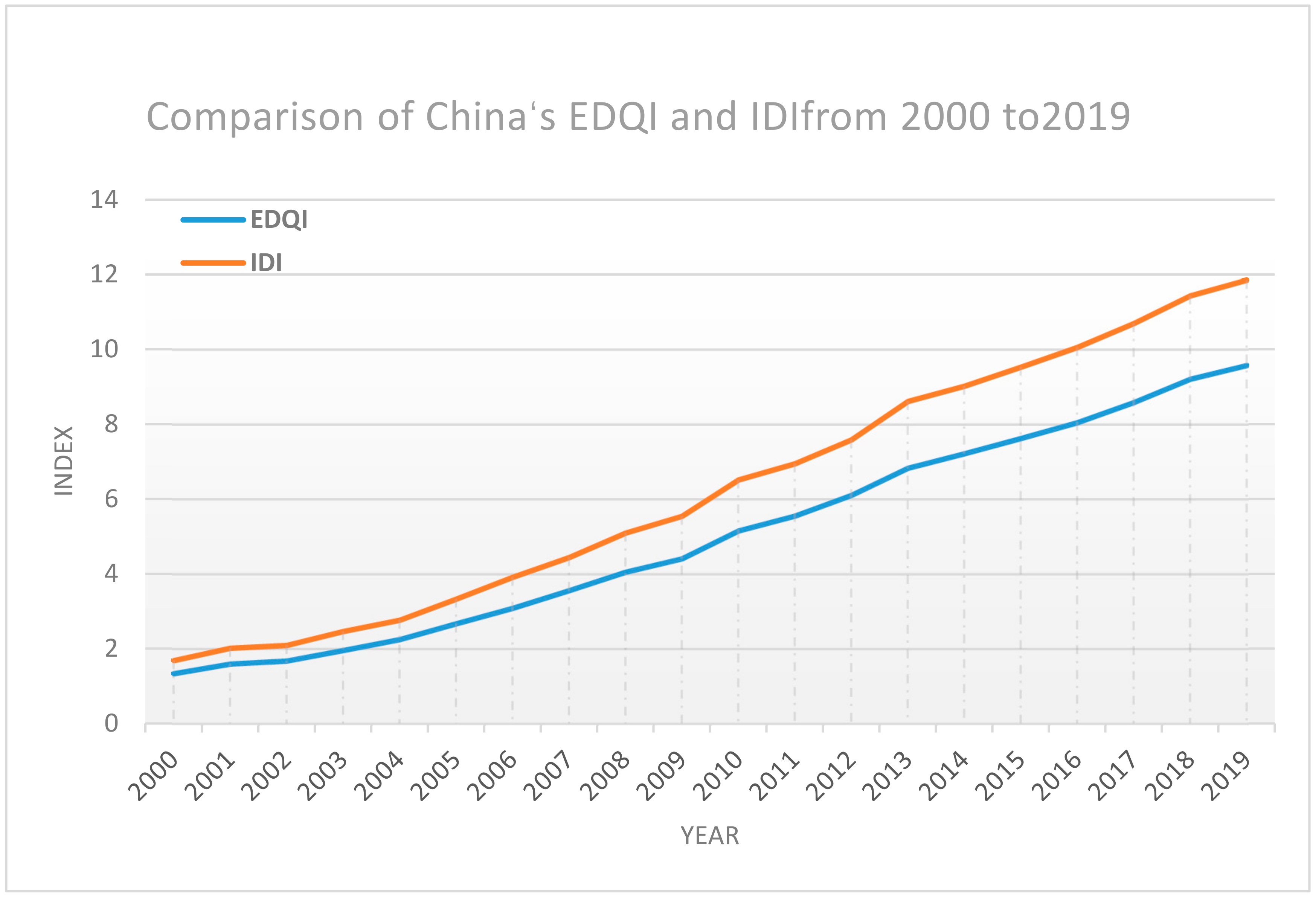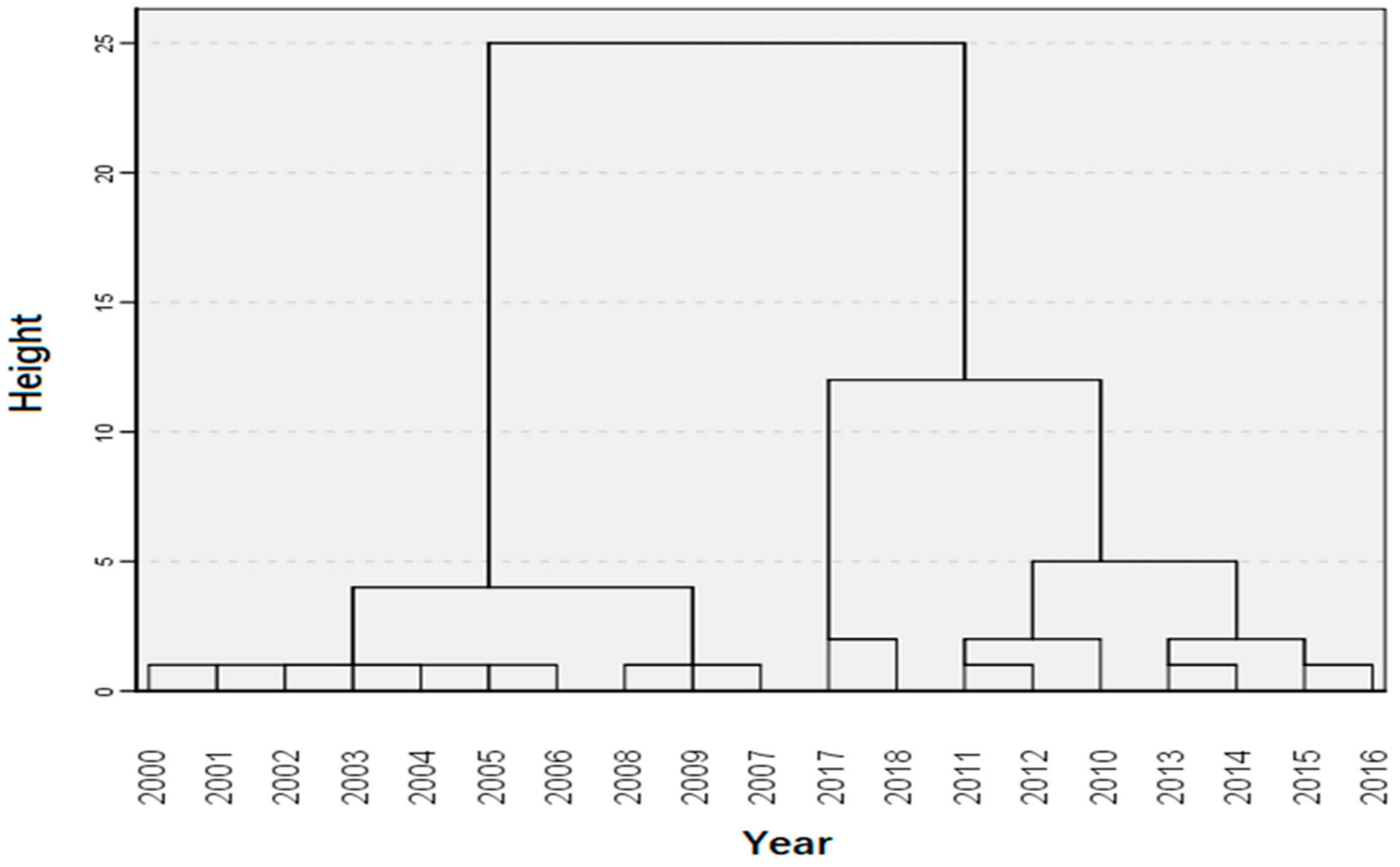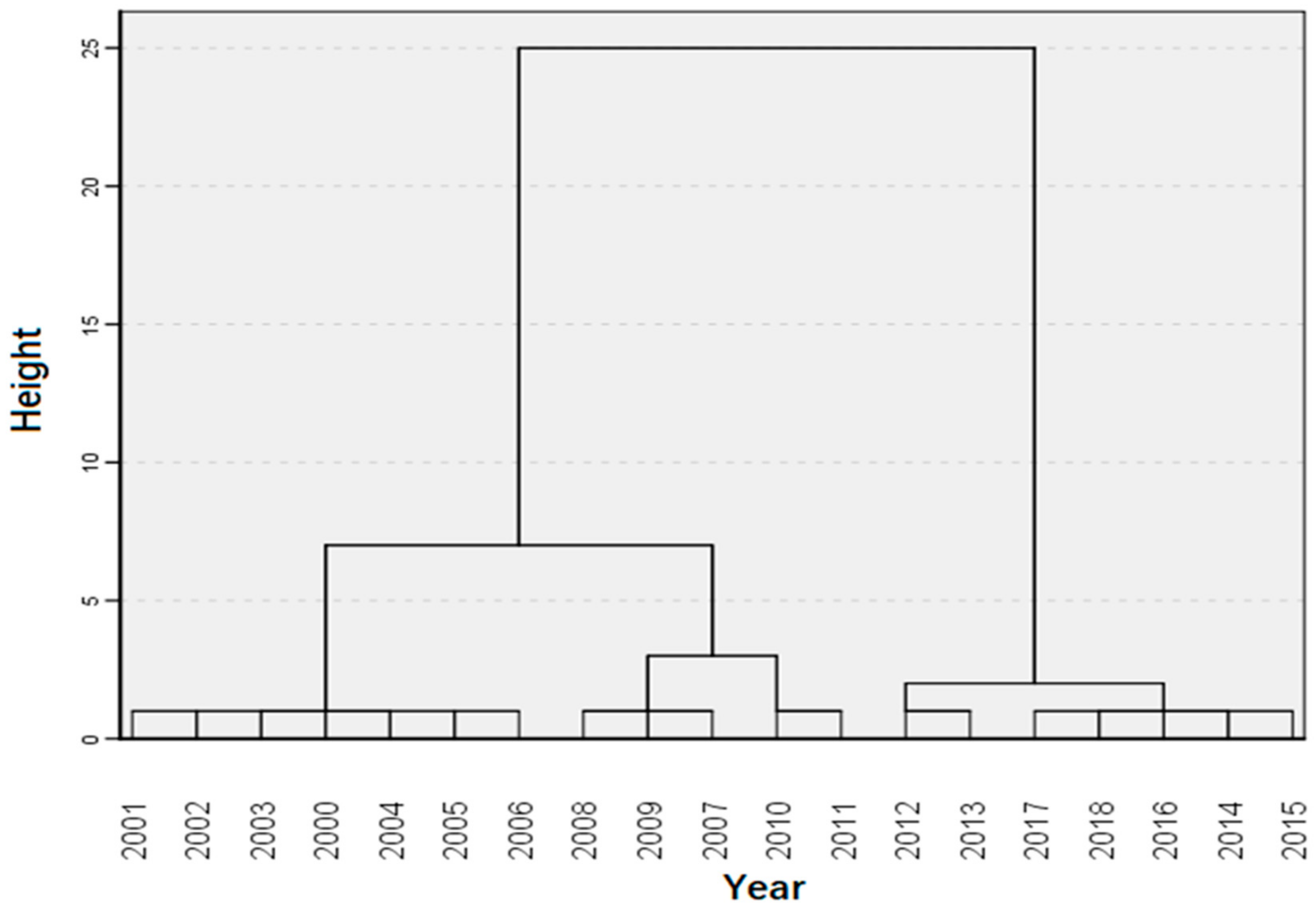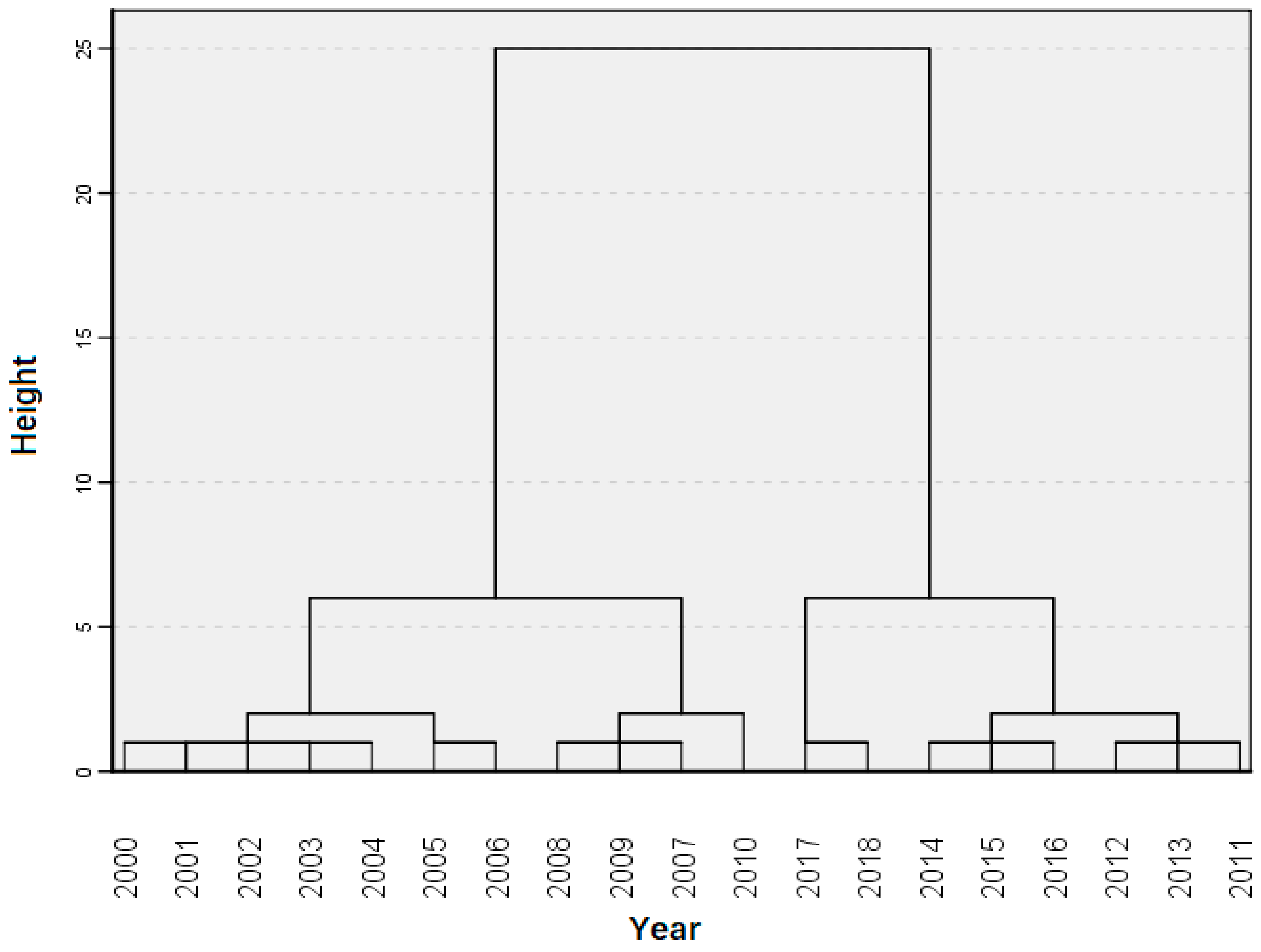The Impact of Innovation-Driven Strategy on High-Quality Economic Development: Evidence from China
Abstract
:1. Background
2. Literature Review
2.1. Innovation-Driven Strategy
2.2. The Relationship between Innovation-Driven Strategy and Economic Development
2.3. The Innovation-Driven Strategy and China
3. Materials and Methodology
- China’s innovation-driven strategy impacts all aspects of the macroeconomy;
- China’s innovation-driven factors have a positive effect on the quality of economic development;
- Innovation driving factors have a positive impact on the quality of economic development (EDQ).
3.1. Materials
3.2. Methodology
3.2.1. Systematic Clustering Method
3.2.2. The Entropy Method
3.2.3. Least Squares Method
3.2.4. Stepwise Regression Method
4. Metrological Analysis
4.1. Entropy Analysis Economic Development Quality Index and Innovation-Driven Index
4.2. Systematic Cluster Analysis of the Impact of Innovation-Driven Strategy on Economic Development in China
4.2.1. Systematic Cluster Analysis of Economic Indicators
4.2.2. System Cluster Analysis on the Impact of Innovation Drive on the Added Value of China’s Industries
4.3. Regression Analysis of Economic Development Quality and Innovation-Driven Economic Indicators
4.3.1. Regression Analysis of EDQI and IDI
4.3.2. Regression Analysis of EDQI and Innovation-Driven (ID)
4.3.3. Model Modification
5. Results of Metrological Analysis
5.1. Results of Systematic Cluster Analysis
5.1.1. Results of Systematic Cluster Analysis of Economic Indicators
5.1.2. Results of Systematic Cluster Analysis of the Added Value of China’s Industries
5.2. Results of Regression Analysis
6. Conclusions and Recommendations
6.1. Conclusions
6.1.1. Conclusions of Cluster Analysis
6.1.2. Conclusions of Regression Analysis
6.2. Recommendations
6.3. Limitations and Future Research
Author Contributions
Funding
Institutional Review Board Statement
Informed Consent Statement
Data Availability Statement
Acknowledgments
Conflicts of Interest
Appendix A
| Ways to Improve the Quality of Driving Economic Development | Performance Indicators Driving the Improvement in Economic Development Quality | The Mechanism of Driving the Quality of Economic Development |
|---|---|---|
| Economic effects | GDP | The economic goal driven by innovation is the economic effect [46]. Through the progress of science and technology, we can realize the innovation of production technology and process, improve production and operation efficiency, and increase the value of each link of the value chain, which reflects the changes in economic aggregate and financial revenue. |
| Fiscal revenues | ||
| Added value of primary industry | ||
| Added value of second industry | ||
| Added value of tertiary industry | ||
| Economic level | The proportion of primary industry in GDP | Technological progress promotes the continuous improvement in economic development and realizes the phased advancement of economic development, which is also proved by the experience of developed countries. |
| The proportion of second industry in GDP | ||
| The proportion of tertiary industry in GDP | ||
| Green economy | The conversion rate of energy processing | An innovation-driven society aims for harmony between the economy and nature [47]. Through innovation, we can reduce energy consumption, reduce economic dependence on resources, and make rational use of them to realize the sustainability of economic development. |
| Investment in environmental pollution control | ||
| Energy consumption | ||
| Total export–import volume | ||
| Coordinated Economy | Total labor productivity | The national innovation system forms the driving force of innovation, guarantees the optimization of an economic development system, and realizes the coordinated development of humans and society, human and nature [48]. It is specifi reflected in the improvement in labor productivity and consumptivecally social expenditure. |
| Rate of high-quality products | ||
| Education funds | ||
| Per capita health expenditure | ||
| Income from social insurance fund | ||
| Catering turnover | ||
| Total cost of domestic tourism | ||
| Innovation economy | Export volume of high tech products | Innovation directly produces economic effects and contributes to the knowledge economy and new economy [49]. |
| Basic expenditure on research and experimental | ||
| Application expenditure of research and experimental | ||
| Experimental expenditure of research and experimental | ||
| Full-time equivalent of R&D personnel | ||
| Turnover of the technology market |
References
- Ma, J.; Guo, M. Technology Innovation Driven Upgrade Strategy Evaluation Model: A Case of Marine Equipment Industry. J. Coast. Res. 2021, 94, 842–845. [Google Scholar] [CrossRef]
- Leavit, H.J. Technology and Organizations: Where’s the off button? Calif. Manag. Rev. 2002, 44, 126–140. [Google Scholar] [CrossRef]
- González-Pernía, J.L.; Jung, A.; Peña, I. Innovation-driven entrepreneurship in developing economies. Entrep. Reg. Dev. 2015, 27, 555–573. [Google Scholar] [CrossRef]
- Hutschenreiter, G.; Zhang, G. China’s quest for innovation-driven growth—The policy dimension. J. Ind. Compet. Trade 2007, 7, 245–254. [Google Scholar] [CrossRef]
- Gao, K.; Yuan, Y. The effect of innovation-driven development on pollution reduction: Empirical evidence from a quasi-natural experiment in China. Technol. Forecast. Soc. Chang. 2021, 172, 121047. [Google Scholar] [CrossRef]
- Yan, M.R.; Chien, K.M.; Hong, L.Y.; Yang, T.N. Evaluating the collaborative ecosystem for an innovation-driven economy: A systems analysis and case study of science parks. Sustainability 2018, 10, 887. [Google Scholar] [CrossRef] [Green Version]
- Zhang, H.; Li, L.J.; Chen, T.T.; Li, V. Where will China’s real estate market go under the economy’s new normal? Cities 2016, 55, 42–48. [Google Scholar] [CrossRef]
- Goh, A.L. Towards an innovation-driven economy through industrial policy-making: An evolutionary analysis of Singapore. Innov. J. Public Sect. Innov. J. 2005, 10, 34. [Google Scholar]
- Krstevski, D. SMEs open innovation management: Strategy map for innovation driven company. Econ. Dev. Ekon. Razvoj 2016, 18, 195–210. [Google Scholar]
- Pinho, J. Institutional theory and global entrepreneurship: Exploring differences between factor- versus innovation-driven countries. J. Int. Entrep. 2017, 15, 56–84. [Google Scholar] [CrossRef]
- Rostami, N.; Khyareh, M.M.; Mazhari, R. Competitiveness, entrepreneurship, and economic performance: Evidence from factor-, efficiency-, and innovation-driven countries. Ekon. Anal. Econ. Ann. 2019, 64, 33–64. [Google Scholar] [CrossRef]
- Apanasyuk, L.A.; Egorova, E.N.; Kryukova, E.M.; Mosalev, A.I.; Mukhomorova, I.V. Socio-ecological education as a factor of economic development. In Proceedings of the International Multidisciplinary Scientific Conference on Social Sciences and Arts SGEM, PARADISE BLUE Congress Center, Albena Resort and SPA, Albena, Bulgaria, 22–31 August 2017; pp. 971–977. [Google Scholar] [CrossRef]
- Kim, S.; Yoon, G. An Innovation-Driven Culture in Local Government: Do Senior Manager’s Transformational Leadership and the Climate for Creativity Matter? Public Pers. Manag. 2015, 44, 147–168. [Google Scholar] [CrossRef]
- Block, A.; Meyerratken, J.; Terlinde, C.; Voß, P.N.; Konhäuser, J.H. When data science meets patent information—Analyzing complex business environments of innovation-driven industries. J. Bus. Chem. 2021, 18, 20–42. [Google Scholar] [CrossRef]
- Kobzeva, L.; Gribov, E.; Snigireva, M.; Raevskaya, V. Cluster Initiative in Fine Chemicals as a Case of Practical Implementation of Triple Helix Collaboration for Regional Economic Growth and Innovation-Driven Development. Manag. Dyn. Knowl. Econ. 2017, 5, 33–56. [Google Scholar] [CrossRef] [Green Version]
- Marsiglio, S.; Tolotti, M. Endogenous growth and technological progress with innovation driven by social interactions. Econ. Theory 2018, 65, 293–328. [Google Scholar] [CrossRef] [Green Version]
- Dobrzanski, P.; Bobowski, S.; Chrysostome, E.; Velinov, E.; Strouhal, J. Toward Innovation-Driven Competitiveness across African Countries: An Analysis of Efficiency of R&D Expenditures. J. Compet. 2021, 13, 5–22. [Google Scholar] [CrossRef]
- Du, W.; Li, M. Government support and innovation for new energy firms in China. Appl. Econ. 2019, 51, 2754–2763. [Google Scholar] [CrossRef]
- Walsh, J.C.; Zeng, Y. Call for Innovation-Driven Development: A Grounded Theory Study of Thai Export-Oriented Garment Industry Facing Competitive Challenges in the Context of Industry 4.0 Era. Acta Univ. Danub. Oecon. 2018, 14, 65–85. [Google Scholar]
- Laužikas, M.; Dailydaitė, S. Impacts of social capital on transformation from efficiency to innovation-driven business. J. Bus. Econ. Manag. 2015, 16, 37–51. [Google Scholar] [CrossRef] [Green Version]
- Crowley, F.; McCann, P. Firm innovation and productivity in Europe: Evidence from innovation-driven and transition-driven economies. Appl. Econ. 2018, 50, 1203–1221. [Google Scholar] [CrossRef]
- Ji, Y. Government-led Economy: Factors Driven or Innovation Driven? Int. J. China Mark. 2014, 4, 97–112. [Google Scholar]
- Tian, G. Deceleration of China’s Economic Growth: Causes and Countermeasures. Front. Econ. China 2019, 14, 3–25. [Google Scholar] [CrossRef]
- Pencea, S.; Bâlgăr, A. China’s Transition to the Innovation-Driven Economy: Stepping Stones and Road-Blocks. Glob. Econ. Obs. 2016, 4, 135–150. [Google Scholar]
- Zhang, H.L.; Xu, S. The Innovation-Driven Impact on Economic Structure Transition. The Case of China. Int. J. Manag. Econ. 2017, 53, 9–26. [Google Scholar] [CrossRef] [Green Version]
- Liu, T.; Li, Y. Green development of China’s Pan-Pearl River Delta mega-urban agglomeration. Sci. Rep. 2021, 11, 15717. [Google Scholar] [CrossRef]
- Wu, F. Supply-Side Structural Reform, and Quality and Efficiency of China’s Economic Transition. China Econ. Transit. CET 2018, 1, 92–100. [Google Scholar]
- Butt, A.S.; Arshi, T.A.; Rao, V.; Tewari, V. Implications of Belt and Road Initiative for Supply Chain Management: A Holistic View. J. Open Innov. 2020, 68, 136. [Google Scholar] [CrossRef]
- Chen, X.; Liu, Z.; Ma, C. Chinese innovation-driving factors: Regional structure, innovation effect, and economic development—Empirical research based on panel data. Ann. Reg. Sci. 2017, 59, 43–68. [Google Scholar] [CrossRef]
- Wonglimpiyarat, J.; Khaemasunun, P. Strategies of remodelling China towards an innovation-driven economy. Int. J. Bus. Innov. Res. 2017, 12, 175–188. [Google Scholar] [CrossRef]
- Liang, L.; Wang, Z.B.; Luo, D.; Wei, Y.; Sun, J. Synergy effects and it’s influencing factors of China’s high technological innovation and regional economy. PLoS ONE 2020, 15, e0231335. [Google Scholar] [CrossRef]
- Freeman, C. Technology Policy and Economic Performance: Lessons from Japan; Pinter Publisher: London, UK, 1987. [Google Scholar]
- Francesco, C.; Adele, P.; Ilaria, T. Green Innovation Development: A Multiple Case Study Analysis. In Proceedings of the European Conference on Innovation and Entrepreneurship, Paris, France, 21–22 September 2017; pp. 116–124. [Google Scholar]
- Zhang, J.K.; Zhang, Y. Examining the economic effects of emissions trading scheme in China. J. Environ. Plan. Manag. 2021, 64, 1622–1641. [Google Scholar] [CrossRef]
- Cuerva, M.C.; Triguero-Cano, Á.; Córcoles, D. Drivers of green and non-green innovation: Empirical evidence in Low-Tech SMEs. J. Clean. Prod. 2014, 68, 104–113. [Google Scholar] [CrossRef]
- Wang, S.; Fan, J.; Zhao, D.; Wang, S. Regional innovation environ-ment and innovation efficiency: The Chinese case. Technol. Anal. Strateg. Manag. 2016, 28, 396–410. [Google Scholar] [CrossRef]
- Fan, F.; Lian, H.; Wang, S. Can regional collaborative innovation improve innovation efficiency? An empirical study of Chinese cities. Growth Chang. 2020, 51, 440–463. [Google Scholar] [CrossRef]
- Kimberly, B. New England’s Rich Widened the Pay Gap in the 1990s, Study Shows. Boston Globe (MA), 6 June 2003. [Google Scholar]
- Milner, A. “That’s Not What I Am”: Teacher Reflections on Purpose, Practice and Professionalism in the Swedish Free School System. FORUM Promot. 3-19 Compr. Educ. 2015, 57, 179–190. [Google Scholar] [CrossRef]
- Zhang, G.Q. Education Model of Industry-University-Research Cooperation in Training Application-oriented innovative Talents. Educ. Sci. Theory Pract. 2018, 18, 3573–3580. [Google Scholar] [CrossRef]
- Coles, L.L.; Pasquier, P. Digital eco-art: Transformative possibilities. Digit. Creat. 2015, 26, 3–15. [Google Scholar] [CrossRef]
- Hu, A.G.Z. Public funding and the ascent of Chinese science: Evidence from the National Natural Science Foundation of China. Res. Policy 2020, 49, 103983. [Google Scholar] [CrossRef]
- Ley, V.; Rey-Campos, J. Research Evaluation: Institutions versus individuals. Rass. Ital. Valutazione 2012, 16, 55–65. [Google Scholar] [CrossRef]
- Cousins, B.; Borras, S.M., Jr.; Sérgio, S.; Ye, J. BRICS, middle-income countries (MICs), and global agrarian transformations: Internal dynamics, regional trends, and international implications. Globalizations 2018, 15, 1–11. [Google Scholar] [CrossRef]
- Meares, C.A.; Sargent, J.F. Technology in the National Interest. Executive Office of the President; ERIC: Washington, DC, USA, 1996; p. 89. [Google Scholar]
- Philipp, L. A Short Story of GDP: On the Influence of GDP on the World Political and Economic Pattern; Suhrkamp Verlag: Berlin, Germany, 2013. [Google Scholar]
- Cao, W.; Zhang, Y.; Qian, P. The Effect of Innovation-Driven Strategy on Green Economic Development in China—An Empirical Study of Smart Cities. Int. J. Environ. Res. Public Health 2019, 16, 1520. [Google Scholar] [CrossRef] [Green Version]
- Zhu, J.R. Study on coordinated development of ecological environment and economy. Fresenius Environ. Bull. 2020, 29, 7934–7939. [Google Scholar]
- Eduardo, C.V.; Mireya, C.M.; Hector, P.L.P. Business Model of Learning Platforms in Sharing Economy. Electron. J. E-Learn. 2020, 18, 102–113. [Google Scholar]






| Year | EDQI | IDI | Year | EDQI | IDI |
|---|---|---|---|---|---|
| 2000 | 1.3405 | 1.6905 | 2010 | 5.1566 | 6.5214 |
| 2001 | 1.5962 | 2.0231 | 2011 | 5.5544 | 6.9523 |
| 2002 | 1.6781 | 2.0961 | 2012 | 6.1055 | 7.5893 |
| 2003 | 1.9584 | 2.4674 | 2013 | 6.8332 | 8.6203 |
| 2004 | 2.2547 | 2.7731 | 2014 | 7.2183 | 9.0244 |
| 2005 | 2.6735 | 3.3352 | 2015 | 7.6266 | 9.5337 |
| 2006 | 3.0865 | 3.9175 | 2016 | 8.0487 | 10.0613 |
| 2007 | 3.5596 | 4.4449 | 2017 | 8.5883 | 10.6997 |
| 2008 | 4.0537 | 5.1023 | 2018 | 9.2116 | 11.4408 |
| 2009 | 4.4125 | 5.5492 | 2019 | 9.5779 | 11.8583 |
| Variable | Coefficient | Std. Error | t-Statistic | Prob. |
|---|---|---|---|---|
| C | −0.030663 | 0.016974 | −1.806507 | 0.0876 |
| IDI | 0.804673 | 0.002388 | 336.9749 | 0.0000 |
| R-squared | 0.999842 | – | – | – |
| Adjusted R-squared | 0.999833 | – | – | – |
| S.E. of regression | 0.035456 | – | – | |
| Sum squared resid | 0.022629 | |||
| Log likelihood | 39.46384 | |||
| F-statistic | 113552.1 | – | – | 0.0000 |
| Mean dependent var | – | – | – | 5.026740 |
| S.D. dependent var | – | – | – | 2.741261 |
| Akaike info criterion | −3.746384 | |||
| Schwarz criterion | −3.646810 | |||
| Hannan–Quinn criter. | −3.726946 | |||
| Durbin–Watson stat | – | – | – | 1.467568 |
| White’s Heteroskedasticity Test: | |||
| F-statistic | 0.784707 | Prob. F(2,17) | 0.4721 |
| Obs*R-squared | 1.690321 | Prob. Chi-Square(2) | 0.4295 |
| Scaled explained SS | 1.298781 | Prob. Chi-Square(2) | 0.5224 |
| Breusch–Godfrey Serial Correlation LM Test: | |||
| F-statistic | 0.361662 | Prob. F(2,16) | 0.7021 |
| Obs*R-squared | 0.865049 | Prob. Chi-Square(2) | 0.6489 |
| Variable | Coefficient | Std. Error | t-Statistic | Prob. |
|---|---|---|---|---|
| C | −4.209206 | 0.630389 | −6.677153 | 0.0000 |
| Ln(X1) | −0.209199 | 0.208410 | −1.003786 | 0.3353 |
| Ln(X2) | −0.255569 | 0.228058 | −1.120633 | 0.2844 |
| Ln(X3) | −0.037478 | 0.119098 | −0.314687 | 0.7584 |
| Ln(X4) | 0.557964 | 0.161817 | 3.448114 | 0.0048 |
| Ln(X5) | 0.040095 | 0.058257 | 0.688239 | 0.5044 |
| Ln(X6) | 0.125458 | 0.037885 | 3.311513 | 0.0062 |
| Ln(X7) | 0.272659 | 0.097024 | 2.810217 | 0.0157 |
| R-squared | 0.999255 | – | – | – |
| Adjusted R-squared | 0.998821 | – | – | – |
| S.E. of regression | 0.021944 | – | – | – |
| Sum squared resid | 0.005778 | – | – | – |
| Log likelihood | 53.11483 | – | – | – |
| F-statistic | 2299.661 | – | – | 0.0000 |
| Mean dependent var | – | – | – | 1.441878 |
| S.D. dependent var | – | – | – | 0.638968 |
| Akaike info criterion | – | – | – | −4.511483 |
| Schwarz criterion | – | – | – | −4.113190 |
| Hannan–Quinn criter. | – | – | – | −4.433732 |
| Durbin–Watson stat | – | – | – | 2.236371 |
| Heteroskedasticity Test: Breusch–Pagan–Godfrey | |||
| F-statistic | 1.460645 | Prob. F(7,12) | 0.2691 |
| Obs*R-squared | 9.201115 | Prob. Chi-Square(7) | 0.2385 |
| Scaled explained SS | 3.365306 | Prob. Chi-Square(7) | 0.8493 |
| Breusch–Godfrey Serial Correlation LM Test: | |||
| F-statistic | 1.158984 | Prob. F(2,10) | 0.3526 |
| Obs*R-squared | 3.763555 | Prob. Chi-Square(2) | 0.1523 |
| Chow Breakpoint Test: 2012 | |||
| F-statistic | 0.825531 | Prob. F(8,4) | 0.6226 |
| Log likelihood ratio | 19.49921 | Prob. Chi-Square(8) | 0.0124 |
| Wald Statistic | 6.604247 | Prob. Chi-Square(8) | 0.5799 |
| Residual unit root Test: | |||
| t-Statistic | Prob. | ||
| Augmented Dickey–Fuller test statistic | −4.352537 | 0.0037 | |
| Variable | Coefficient | Std. Error | t-Statistic | Prob. |
|---|---|---|---|---|
| C | −3.756096 | 0.065860 | −57.03146 | 0.0000 |
| Ln(X4) | 0.365411 | 0.045884 | 7.963875 | 0.0000 |
| Ln(X6) | 0.125797 | 0.025045 | 5.022866 | 0.0001 |
| Ln(X7) | 0.127342 | 0.031833 | 4.000300 | 0.0010 |
| R-squared | 0.998989 | – | – | – |
| Adjusted R-squared | 0.998799 | – | – | – |
| S.E. of regression | 0.022141 | – | – | – |
| Sum squared resid | 0.007844 | – | – | – |
| Log likelihood | 50.05882 | – | – | – |
| F-statistic | 5269.178 | – | – | 0.0000 |
| Mean dependent var | – | – | – | 1.441878 |
| S.D. dependent var | – | – | – | 0.638968 |
| Akaike info criterion | – | – | – | −4.605882 |
| Schwarz criterion | – | – | – | −4.406736 |
| Hannan–Quinn criter. | – | – | – | −4.567007 |
| Durbin–Watson stat | – | – | – | 2.163606 |
Publisher’s Note: MDPI stays neutral with regard to jurisdictional claims in published maps and institutional affiliations. |
© 2022 by the authors. Licensee MDPI, Basel, Switzerland. This article is an open access article distributed under the terms and conditions of the Creative Commons Attribution (CC BY) license (https://creativecommons.org/licenses/by/4.0/).
Share and Cite
Xiao, W.; Kong, H.; Shi, L.; Boamah, V.; Tang, D. The Impact of Innovation-Driven Strategy on High-Quality Economic Development: Evidence from China. Sustainability 2022, 14, 4212. https://doi.org/10.3390/su14074212
Xiao W, Kong H, Shi L, Boamah V, Tang D. The Impact of Innovation-Driven Strategy on High-Quality Economic Development: Evidence from China. Sustainability. 2022; 14(7):4212. https://doi.org/10.3390/su14074212
Chicago/Turabian StyleXiao, Wensheng, Haojia Kong, Lifan Shi, Valentina Boamah, and Decai Tang. 2022. "The Impact of Innovation-Driven Strategy on High-Quality Economic Development: Evidence from China" Sustainability 14, no. 7: 4212. https://doi.org/10.3390/su14074212
APA StyleXiao, W., Kong, H., Shi, L., Boamah, V., & Tang, D. (2022). The Impact of Innovation-Driven Strategy on High-Quality Economic Development: Evidence from China. Sustainability, 14(7), 4212. https://doi.org/10.3390/su14074212







